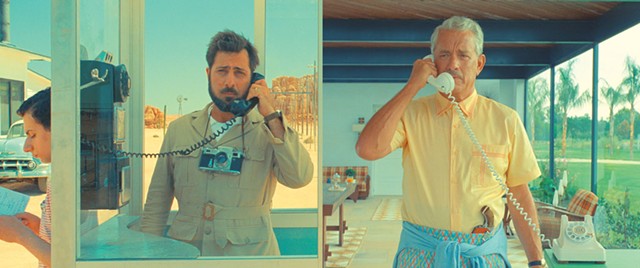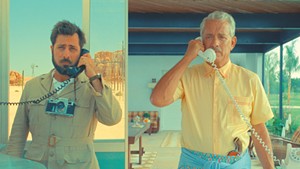
- Courtesy Of Pop. 87 Productions/Focus Features
- Schwartzman and Hanks have trouble communicating in Anderson's touching riff on midcentury dramatic conventions.
It's safe to say that theater has a special place in Wes Anderson's heart. In the director's breakthrough film, Rushmore, Jason Schwartzman plays a teen who produces elaborate spectacles on the stage of his high school. More than two decades later, Schwartzman stars in Anderson's latest, Asteroid City, as the lead of an acclaimed stage play that is also part of the movie we're watching.
Currently screening at several theaters in our area, Asteroid City is a feast for the eyes that highlights the mechanics of dramaturgy perhaps more than any previous Anderson film.
The deal
Remember those anthology television series that introduced viewers to "serious" works of American theater? Unless you were around in the 1950s or '60s, you probably don't. But now you're watching one, and the host (Bryan Cranston) is leading you through the making of Asteroid City, by acclaimed playwright Conrad Earp (Edward Norton) in very serious black and white.
Then the aspect ratio widens, and the play's action takes over the screen in a riot of pastel hues rarely seen outside midcentury photos of the American Southwest. The year is 1955, and war photographer Augie Steenbeck (Schwartzman) has brought his teenage son, Woodrow (Jake Ryan), to the desert outpost of Asteroid City for a junior stargazers' convention. He uses the occasion belatedly to inform Woodrow and his younger siblings that their mother has expired, presenting them with her ashes in a Tupperware container.
While Augie begins a bittersweet flirtation with movie star Midge Campbell (Scarlett Johansson), the resident scientist (Tilda Swinton) introduces the young stargazers to the giant meteor crater for which the town is named.
Will a surprise alien sighting help Woodrow to process his grief? Will Earp and director Schubert Green (Adrien Brody) stage their play with success? Stay tuned.
Will you like it?
The central irony of Asteroid City is that Asteroid City wouldn't have been considered a "serious drama" in the '50s. Its plot is a riff on the type of sci-fi movies that are now beloved classics but were widely viewed in their day as schlocky, juvenile entertainment.
Clearly Anderson knows this, because the role Midge is rehearsing — a doomed wife in a kitchen-sink drama — is the type of thing that midcentury audiences took seriously. Today, her lines come off as stagy and stylized, as do many of the scenes in the film's supposedly factual frame story. With their showily quippy dialogue, they bear the imprint of old Hollywood show-biz dramas.
The play within the film feels almost naturalistic by comparison. While its physical world is transparently fake — a giant desert diorama that evokes a stage set — the humor of these scenes is oblique and terse. The characters circle coyly around emotional minefields rather than plunge into them. In short, the supposed stage play offers what we expect from a Wes Anderson movie: real people in an artificial world.
Asteroid City is pleasant enough to watch for the pastiche alone. As a fan of the sun-swept retro aesthetic Anderson channels in the desert scenes, I was mesmerized by images such as the delicate shadow of a trellis or cherry-patterned curtains framing salmon-colored sands. Most of the characters don't rise above familiar archetypes: nerdy whiz kids, an earthy mechanic (Matt Dillon), a pompous general (Jeffrey Wright), an oily motel manager (Steve Carell). But it's fun to watch their interactions, which are always touched with the absurd. The motel even comes equipped with a vending machine for martinis, in a nod to the midcentury passion for automating all things.
What's the point of all these different levels of reality and artifice? As we watch, we may begin to trace correspondences between the frame story and the "play." Midge and the actor playing her are both troubled and tempestuous. Augie and the actor playing him have both suffered a recent loss.
Those similarities remain subtle, though. There's no one-to-one mapping of fiction to reality here, perhaps because Anderson wants to suggest that fiction should have the freedom to mean anything — or nothing. Early in the film, we hear about an occurrence in the stage play that even its author can't explain. Later, after we've seen that moment play out, the star confronts his director, who tells him to stop worrying about the deeper meaning and "just keep telling the story."
That line could be read as a thesis statement, given that Anderson has often been accused of valuing style over substance. But there's no postmodern complacency here: The actor's irritation with his character's lack of motivation turns out to be the setup for one of the most emotionally raw scenes that Anderson has ever done. Asteroid City may be a fiction inside a fiction inside a secondhand version of the past, but it does sometimes touch us in real ways.
If you like this, try...
Moonrise Kingdom (2012; Prime Video until June 30, rentable): Of all Anderson's movies, Asteroid City reminds me most of this wistful period piece set in 1963 on an island in New England.
Fantastic Mr. Fox (2009; Max, Cinemax, rentable): Schwartzman's performance as Augie builds on his roles in previous Anderson films. In this stop-motion animation, he voices the resentful son of an overbearing dad, prefiguring Augie's problems with his father-in-law (Tom Hanks).
The Vast of Night (2020; Prime Video): If you prefer your self-consciously retro alien incursion movies with more dread (à la "The Twilight Zone") and less whimsy, you need to see this inventive indie set in 1950s New Mexico.






Comments
Comments are closed.
From 2014-2020, Seven Days allowed readers to comment on all stories posted on our website. While we've appreciated the suggestions and insights, right now Seven Days is prioritizing our core mission — producing high-quality, responsible local journalism — over moderating online debates between readers.
To criticize, correct or praise our reporting, please send us a letter to the editor or send us a tip. We’ll check it out and report the results.
Online comments may return when we have better tech tools for managing them. Thanks for reading.